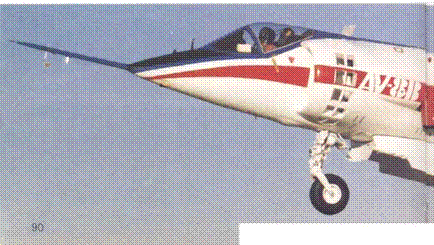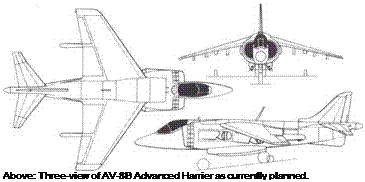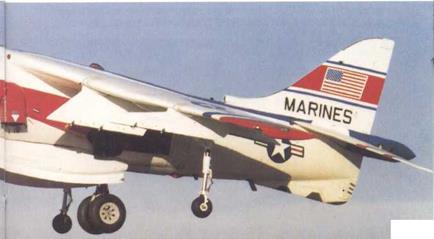McDonnell Douglas/Hawker AV-8B
AV-8B and proposed variants
Origin: McDonnell Douglas Corporation (MCAIR, St Louis), USA: principal associate, British Aerospace (Hawker Aircraft, Kingston), UK. Type: V/STOL light attack: proposed versions include sea-based air defence, reconnaissance and dual trainer/multi-role.
Engine: One Rolls-Royce Pegasus 103. (Pratt & Whitney F402) vectored – thrust turbofan rated at 21,5001b (9752kg).
Dimensions: Span 30ft З5ІП (9-20m); length 42ft 11 in (13-1m): height 11ft 3iin (3-4m).
Weights: Empty 12,4001b (5625kg): design, 22,7501b (10,320kg): loaded (close-support seven Mk 82 bombs) 25,994lb (11,790kg): maximum over 29,000lb (13,150kg).
Performance: Maximum speed, clean, over Mach 1: operational radius (VTO, 7,800lb/3538kg weapons) 115 miles (185km), (STO, 12 Mk 82 Snakeye, internal fuel) 172 miles (278km), (STO, seven Mk 82, external fuel) 748 miles (1204km): ferry range over 3,000 miles 4830km). Armament: Two 20mm Mk 12 cannon in single belly pods, six underwing pylons and centreline hardpoint for weapon/ECM/fuel load of 8,000!b (3630kg) for VTO or 9,000lb (4080kg) for STO.
History: First flight (YAV-8B) 9 November 1978: operational capability originally planned for 1981—2.
Users: US Marine Corps, US Navy.

Development: Following proposals in 1973 by Hawker Siddeley and McDonnell Douglas for an advanced development of the Harrier the then UK Defence Minister, Roy Mason, said there was "not enough common ground" for a joint programme. This caused a delay of many months, but the US government eventually studied an improved aircraft designated AV-16A with a new wing and the uprated Pegasus 15 engine, before deciding to try to achieve as much as possible of the same advantages in payload/range and weapon load with the existing engine. Rolls-Royce and Pratt & Whitney have studied the Pegasus 11D (800lb extra thrust) and 11+ (1,0001b more) but these remained mere proposals as this book went to press, despite the fact Rolls-Royce ran a Pegasus at over 25,0001b thrust in May 1972. Under the present programme all changes are confined to the airframe, the main improvement being a completely new wing, with greater
 |
span and area, less sweep, a supercritical section and graphite-epoxy construction throughout the main wing box and large single-slotted flaps and drooping ailerons. Strakes and a large hinged belly flap will increase air pressure under the fuselage in VTO, while other changes include inlets matched to the engine (they are too small on previous production Harriers) and front nozzles cut off square with the efflux.
Overall improvement in payload/range. compared with an AV-8A, is about 100 per cent. There is still a chance that further gains may result from improvement to the F402 engine, and production AV-8Bs may have the raised cockpit of the British Sea Harrier. The US Marine Corps requirement is for 336, and a variant might possibly be purchased by the US Navy for its own use. Present plans envisage the AV-8B having the Angle-Rate Bombing System, with dual-mode TV and laser spot coupled via IBM computer to the Marconi-Elliott HUD. Fixed or retractable probe refuelling is likely, but radar will not be fitted. Two AV-8As were rebuilt by McDonnell Douglas as YAV-8Bs, and have performed very well in Navy/Marine Corps trials, but Congress has consistently shown itself hostile to what it regards as a foreign aircraft and production funds had been withheld as this book went to press despite sustained pleas from the Marines. The Navy has been more muted, but also wants a radar-equipped version known as AV-8B – Plus. If Congress should release funds, production aircraft would have about half British content, but would be assembled at St Louis.

Below: The first of two YAV-8B trials aircraft (rebuilt from AV-8As), hovering at the McDonnell Douglas plant at St Louis after 9 November 1978, which was when this important prototype first got its wheels off the ground.










